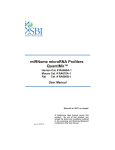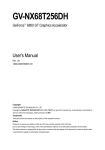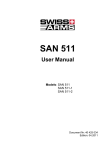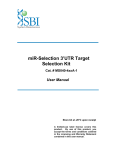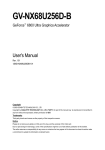Download miRNome microRNA Profilers QuantiMir™
Transcript
miRNome microRNA Profilers QuantiMir™ Human Cat. # RA660A-1 Mouse Cat. # RA670A-1 Rat Cat. # RA680A-1 User Manual Store kit at -20°C on receipt (ver. 1-090514) A limited-use label license covers this product. By use of this product, you accept the terms and conditions outlined in the Licensing and Warranty Statement contained in this user manual. miRNome microRNA Profilers Human Cat. # RA660A-1 Mouse Cat. # RA670A-1 Contents I. Introduction and Background A. Overview B. miRNome microRNA qPCR profiler workflow C. How QuantiMir cDNA synthesis works 2 3 4 II. Protocol A. B. C. D. E. F. QuantiMir RT reaction set up Real-time qPCR Reaction setup How the microRNA specific primers are designed miRNome microRNA Array arrangements List of Components Additional Required Materials 5 6 8 8 9 9 III. Quality Control and Sample Data A. miRNome Array Primer Validation Tests & Endogenous Controls B. Sensitivity Tests C. Specificity Tests D. Sample Data 10 12 13 14 IV. Troubleshooting 15 V. General References VI. MicroRNA and Cancer References VII. Related products VIII. Technical Support IX. Licensing and Warranty Statement 16 17 19 20 21 888-266-5066 (Toll Free) 650-968-2200 (outside US) Page 1 System Biosciences (SBI) User Manual I. Introduction and Background A. Overview This manual provides details and information necessary to use the QuantiMir RT Kit to tag and convert small non-coding RNAs into detectable and quantifiable cDNAs. The system allows for the ability to quantitate fold differences of microRNAs between 20 separate experimental RNA samples. The array plate also includesthree endogenous RNA assays as normalization signals. To ensure optimal results, please read the entire manual before using the reagents and material supplied with this kit. These MicroRNA qPCR Array Panels come with all the reagents necessary to tag and convert small RNAs from 20 different total RNA samples into quantifiable cDNA using the sensitive QuantiMir™ technology. The kits include assays in pre-formatted plates for either all human (cat# RA660A-1) or all mouse (cat# RA670A-1) individual microRNAs with three endogenous reference RNA controls on each plate. All microRNA assays based on the Sanger miRBase microRNA database registered entries. Page 2 ver.1-080721 www.systembio.com miRNome microRNA Profilers Human Cat. # RA660A-1 Mouse Cat. # RA670A-1 B. miRNome microRNA qPCR profiler workflow miRNome microRNA Profiler Workflow What this Profiling Array Kit does: The miRNome microRNA Profilers enable the quantitation of all registered microRNAs along with 3 endogenous RNA controls for normalization. 1. QuantiMir cDNA technology tags and converts all small RNAs into cDNAs, ready to use as template for real-time qPCR. 2. Create mastermix with QuantiMir cDNA, 3’ universal reverse primer and 2X SYBR Green, pipet into qPCR optimcal 384-well plate. 3. Pipet 1 µl of each of the microRNA assays from the miRNome assay stock plate into each well separately. 4. Perform Real-time qPCR runs using standard run conditions (40 cycles, 60ºC anneal/extension) 888-266-5066 (Toll Free) 650-968-2200 (outside US) Page 3 System Biosciences (SBI) User Manual C. How QuantiMir cDNA synthesis works Page 4 ver.1-080721 www.systembio.com miRNome microRNA Profilers Human Cat. # RA660A-1 Mouse Cat. # RA670A-1 II. Protocol A. QuantiMir RT reaction setup (for 1 RNA sample to be assayed on multiple qPCR 384-well plate) It is important to start with total RNA that includes the small RNA fraction. RNA input can be as low as 100 ng total. For optimum signals, perform the following. Dilute your RNA to ~160 ng/μl Start: In a thin-walled PCR tube or PCR-compatible plate well combine: 5 μl Total RNA (~ 800 ng) 2 μl 5X PolyA Buffer + 1 μl 25mM MnCl2 1.5 μl 5mM ATP 0.5 μl PolyA Polymerase 10 μl STEP 1: PolyA Tail Incubate for 30 min. at 37°C Add: + 0.5 μl Oligo dT Adapter STEP 2: Anneal Anchor dT Adapter Heat for 5 min. at 60°C Let cool to room temp for 2 min. Add: STEP 3: Synthesize cDNAs + 4 μl 5X RT Buffer 2 μl dNTP mix 1.5 μl 0.1M DTT 1.5 μl Nuclease-free H2O 1 μl Reverse Transcriptase 20.5 μl Total in tube Incubate for 60 min. at 42°C Heat for 10 min. at 95°C Done! * The QuantiMir cDNAs can be stored at -20°C. For more sensitive applications, a single phenol:chloroform extraction with ethanol precipitation can be performed on the cDNA to remove proteins, unused dNTPs and primers, typically this is not necessary. 888-266-5066 (Toll Free) 650-968-2200 (outside US) Page 5 System Biosciences (SBI) User Manual B. Real-time qPCR Reaction Setup 1. Mastermix qPCR Reaction Set up for ONE entire 384-well qPCR plate To determine the expression profile for your miRNAs under study, mix the following for 1 entire 384 qPCR plate: For 1 entire plate : 1150 μl 2X SYBR Green* qPCR Mastermix buffer + 39 μl Universal Reverse Primer (10μM) 5 μl User-synthesized QuantiMir cDNA 1090 μl Nuclease-free water 2284 μl Total Aliquot 5μl of Mastermix into every well in your 384-well qPCR Plate * SBI has tested and recommends SYBR Green Master mix from three vendors: 1. Power SYBR Master Mix® (Cat numbers 4368577, 4367650, 4367659, 4368706, 4368702, 4368708, 4367660) from Applied Biosystems 2. SYBR GreenER™ qPCR SuperMix for ABI PRISM® instrument from Invitrogen (Cat numbers 11760-100, 11760-500, and 11760-02K) 3. RT² Real-Time™ SYBR Green / ROX PCR (Cat numbers PA-012 and PA-112) from SuperArray. Resuspend the MicroRNA assay Primers with 20μl water in each well before use. Spin briefly to collect contents at bottom of wells. Then : Load 1μl per well of each of the Primers from the Primer Stock plate into your qPCR plate (well A1 into qPCR plate A1, etc.) Once reagents are loaded into the wells, cover the plate with an optical adhesive cover and spin briefly in a centrifuge to bring contents to bottom of wells. Place plate in the correct orientation (well A1, upper left) into the Real-time qPCR instrument and perform analysis run. * Use a Multichannel pipette to load the qPCR plate with MasterMix and Primers: Pour the Mastermix into a reservoir trough and use a 8 or 12 channel pipette to load the entire 384-well qPCR plate with the Mastermix. Then load the primers from the primer plate to the qPCR plate using a separate multichannel pipette. Page 6 ver.1-080721 www.systembio.com miRNome microRNA Profilers Human Cat. # RA660A-1 Mouse Cat. # RA670A-1 2. Real-time qPCR Instrument Parameters Follow the guidelines as detailed for your specific Real-time instrumentation. The following parameters tested by SBI were performed on an Applied Biosystems 7900HT Real-time PCR System but can also apply to any other 384-well system. The details of the thermal cycling conditions used in testing at SBI are below. A screenshot from SBI’s 7900HT Real-time instrument setup is shown below also. Default conditions are used throughout. Create a detector: Instrument setup: qPCR cycling and data accumulation conditions: Standard Protocol 1. 50°C 2 min. 2. 95°C 10 min. 3. 95°C 15 sec. 4. 60°C 1 min. (40 cycles of Stage 3), data read at 60°C 1 min. Step. An additional recommendation is to include a Dissociation Stage after the qPCR run to assess the Tm of the PCR amplicon to verify the specificity of the amplification reaction. Refer to the User Manual for your specific instrument to conduct the melt analysis and the data analyses of the amplification plots and Cycle Threshold (Ct) calculations. In general, Cycle thresholds should be set within the exponential phase of the amplification plots with software automatic baseline settings. 888-266-5066 (Toll Free) 650-968-2200 (outside US) Page 7 System Biosciences (SBI) User Manual C. How the miRNA-specific primers are designed for Detection and Quantitation in the Array MicroRNAs typically range in size from 19 – 24 nt. We recommend using the exact sequence of the miRNA or siRNA being studied when designing the forward primer. If the miRNA under study is known and documented, using the miRBase database can be an easy starting point : (http://microrna.sanger.ac.uk/sequences/search.shtml). An example of the known and documented miRNA, Human miR-16, is shown below. Hsa-miR-16 Simple: Directly use sequence of mature miRNA as forward primer in oligo design. The mature miRNA sequence 5’ – uagcagcacguaaauauuggcg – 3’ can be simply converted to a DNA sequence and used directly as the forward primer for end-point and qPCR analysis. Forward primer for hsa-miR-16 (included in kit): 5’ – TAGCAGCACGTAAATATTGGCG – 3’ Tm= 58.9 °C, 45% GC and length =22 bases. All of the Micro-RNA-specific primers for the HT 384 microRNA Profiler were designed in this fashion. D. miRNome MicroRNA Profiler Array arrangement The array plate contains assays for microRNAs and also includes three endogenous reference RNAs as normalization signals. See accompanying data CD for access to these details. Page 8 ver.1-080721 www.systembio.com miRNome microRNA Profilers Human Cat. # RA660A-1 Mouse Cat. # RA670A-1 E. List of Components Each miRNome microRNA Profiler Kit contains the following components with enough material to perform at least 20 QuantiMir cDNA synthesis reactions and enough Primers in the microRNA assay array plate to perform 20 384-well qPCR plate sets as outlined in this manual: Optimized for 6 μl qPCR reactions 40 μl 5X PolyA polymerase Buffer 10 20 30 10 μl μl μl μl PolyA polymerase 25 mM MnCl2 5 mM ATP 3’ Oligo dT Adaptor 80 20 30 50 2400 20 μl μl μl μl μl μl 5X Reverse Transcriptase Buffer Reverse Transcriptase 0.1 M Dithiothreitol (DTT) dNTP Mix 3’ Universal Reverse PCR Primer Each of microRNA assays + three controls ml RNase-free Water 1.2 The kit is shipped on blue ice and should be stored at -20°C upon arrival. Properly stored kits are stable for 1 year from the date received. Resuspend each primer assay well with 20μl water before use. F. Additional Required Materials • • • • • • • • Nuclease-free water for qPCR reactions Real-time qPCR Instrument Instrument-specific optical qPCR plates Thermocycler (with heated lid) Thermocycler PCR tubes or plates for end-point reactions PCR Mastermix, including Taq polymerase for PCR 3.0-3.5% Agarose Gel in Tris-Borate EDTA (TBE) or Tris-Acetate EDTA (TAE) Buffer DNA Size Ladder with markers from 50 to 2,000 bp (Bio-Rad AmpliSize™ DNA Ladder; Cat. # 170-8200) IMPORTANT: • Recommended 2X SYBR Green qPCR Mastermixes SBI has tested and recommends SYBR Green Master mix from three vendors: Power SYBR Master Mix® (Cat numbers 4368577, 4367650, 4367659, 4368706, 4368702, 4368708, 4367660) from Applied Biosystems; SYBR GreenER™ qPCR SuperMix for ABI PRISM® instrument from Invitrogen (Cat numbers 11760-100, 11760-500, and 11760-02K); and RT² Real-Time™ SYBR Green / ROX PCR (Cat numbers PA-012 and PA-112) from SuperArray. 888-266-5066 (Toll Free) 650-968-2200 (outside US) Page 9 System Biosciences (SBI) User Manual III. Quality Control and Sample Data A. miRNome Array Primer Validation Tests & endogenous Controls ● Real-time qPCR validation The miRNome microRNA Profiler qPCR Array plates were tested using a 500 ng RNA sample converted to cDNA using the QuantiMir RT Kit. The resulting cDNA was tested using about 1 ng cDNA per well. Shown above is the resulting Real-time amplification plot for the entire plate. The Cts ranged from 16.15 to 37.8 and the Ct value for the Human U6 assay was 26.2 in this experiment. Page 10 ver.1-080721 www.systembio.com miRNome microRNA Profilers Human Cat. # RA660A-1 Mouse Cat. # RA670A-1 ● Endogenous control assays 888-266-5066 (Toll Free) 650-968-2200 (outside US) Page 11 System Biosciences (SBI) B. User Manual Sensitivity Tests The QuantiMir cDNAs were synthesized using decreasing amounts of total starting RNA input from a pool of Human Brain, Heart, Kidney, Placenta and Testes RNAs. Real-time quantitative qPCR assays were performed with Forward primers specific for Human miR-16. Fig 4. Real-time qPCR data for Human miR-16. Real-time qPCR amplification plots are shown in the upper inset. Cycle threshold (Ct) values were determined using the software automatic baseline and Ct settings. The Bar graph depicts the relative %Signal per RNA input amount for the 2 microRNA. The graph below shows the linear regression analysis with a R value of 0.989 for miR-16. Page 12 ver.1-080721 www.systembio.com miRNome microRNA Profilers C. Human Cat. # RA660A-1 Mouse Cat. # RA670A-1 Specificity Tests Fig 5. The QuantiMir cDNA sets were synthesized from 18 separate normal Human tissues and tested with 2 primers specific for 2 known miRNA molecules: miR-1 (heart and skeletal muscle-specific) and miR-122a (abundant in liver). The corresponding expression bar graphs are shown in Fig. 5. above. These two known miRNAs, miR-1 and mir-122a, have very specific tissue expression patterns. Real-time qPCR data confirmed that miR-1 is restricted to skeletal muscle and heart. The sensitivity of the assays also reveals very low but detectable signals in additional tissues. miR-122a is known to be highly abundant in liver. Tissue tested: 1 2 3 4 5 6 adipose bladder brain cervix colon esophagus 888-266-5066 (Toll Free) 7 8 9 10 11 12 heart kidney liver lung ovary placenta 13 14 15 16 17 18 prostate skeletal muscle small intestine spleen testes thymus 650-968-2200 (outside US) Page 13 System Biosciences (SBI) D. User Manual Sample Data 1. Analysis of Tumor and Normal Tissue MicroRNA expression levels using the QuantiMir Kit and Real-time qPCR The QuantiMir cDNAs were synthesized from both Normal and Tumor Breast, Lung, Ovary, Colon and Lymph node RNAs. MicroRNA forward primers specific for miR-9-1, miR-155, miR-125, miR-145, miR-7, miR-17-3p, miR-18a, miR-20a and miR-92 were using to detect the corresponding microRNA species in the tissues detailed in the expression graph below (Fig. 6.). The signals were normalized to expression levels of the U6 snRNA transcript. Fold increases and decreases in Normal vs. Tumor tissues are graphed below and are consistent with published findings for the particular microRNA in the specific tumor type. Fig. 6. Quantitative analysis of MicroRNA expression in tumor and normal tissue samples. The Bar graph data are grouped by tissue type with normal tissues in blue bars and tumor tissues in red bars. The specific MicroRNAs being detected are listed below the bar graphs. The expression levels are normalized to U6 snRNA transcript levels to control for RNA input. The MicroRNA expression levels are depicted as ΔCt vales (Y axis). Real-time assays were performed as described in Section II D of this manual. Fold changes for these specific microRNAs and the particular tumor type are documented in the literature and verified using the QuantiMir RT kit and the selected miRNA primers from the Cancer Array shown above. See MicroRNA and Cancer References in Section VI. Page 14 ver.1-080721 www.systembio.com miRNome microRNA Profilers Human Cat. # RA660A-1 Mouse Cat. # RA670A-1 IV. Troubleshooting Problem Too much background in qPCR signals Possible Solution Use much less cDNA in the SYBR Green Mastermix. No qPCR signals Did you select SYBR Green as the Detector’s Reporter Dye? Did the controls work? Use more cDNA in Mastermix. Check Mastermix contents and try a subset with the controls as a positive control. Also try lowering the Annealing Temperature to 50ºC. How do I select the Threshold level Typically place the threshold setting in for Ct analysis ? the upper third of the exponential phase of the amplification curve. Also see the User Manual for your specific instrument or phone their technical support team for guidance. 888-266-5066 (Toll Free) 650-968-2200 (outside US) Page 15 System Biosciences (SBI) User Manual V. General References 1. Sonthelmer, E. J., Carthew, R. W. 2005. Silence from within: Endogenous siRNAs and miRNAs. Cell 122:9-12. 2. Zamore, P.D., Haley, B. 2005. Ribo-gnome: The big world of small RNAs. Science 309: 1519-1524. 3. Bartel, D. 2004. MicroRNAs: Genomics, Biogenesis, Mechanism, and Function. Cell 116: 281-297. 4. Kim, Narry V. 2005.Small RNAs: Classification, Biogenesis, and Function. Mol. Cells. 19:1-15. 5. Valencia-Sanchez, MA., Liu, J., Hannon, GJ., Parker, R., 2006. Control of translation and mRNA degradation by miRNAs and siRNAs. Genes Dev 20: 515-525. 6. Lewis B.P, Burge C.B, Bartel, D.P. 2005. Conserved seed pairing, often flanked by adenosines, indicates that thousands of human genes are microRNA targets. Cell 120: 15-20. 7. Xie X., Lu J., Kulbokas, E.J., Goulub, T.R., Mooth, V., Lindblad-Toh, K., Lander, E.S. and Kellis, M. Systematic discovery of regulatory motifs in human promoters and 3’ UTRs by comparison of several mammals. Nature.434:338-45. 8. Lagos-Quintana, M., Rauhut, R., Lendeckel, W., Tuschl, T. 2001. Identification of Novel Coding for Small Expresses RNAs. Science 294: 853-858. 9. Basyuk, E., Suavet, F., Doglio, A., Bordonne, R., Bertrand, E. 2003. Human let-7 stem-loop precursors harbor features of RNase III cleavage products. Nucleic Acids Res 31: 6593-6597. 10. Chomczynski P., and Mackey, K. One-hour downward capillary blotting of RNA at neutral pH. 1994, Anal. Biochem. 221, 303-305. 11. Shi, R., Chiang, V.L., 2005. Facile means for quantifying microRNA expression by real-time PCR. BioTechniques. 39:519-525. 12. Ding, Y., Chan, C.Y., and Lawrence, C.E. (2005) RNA secondary structure prediction by centroids in a Boltzmann weighted ensemble. RNA 11, 1157-1166. 13. Griffiths-Jones,S., Grocock, R.J., Van Dongen, S., Bateman, A., Enright, A.J. 2006. miRBase: microRNA sequences, targets and gene nomenclature. Nucleic Acids Research 34: D140-D144. 14. Shingara, J., Keiger, K., Shelton, J., Laosinchai-Wolf, W., Powers, P., Conrad, R., Brown, D., Labourier, E. 2005. An optimized isolation and labeling platform for accurate microRNA expression profiling. RNA 11:1461-1470. 15. He, L., Thomson, J.M., Hemann, M.T., Hernando-Monge, E., Mu, D., Goodson, S., Powers, S., Cordon-Cardo, C., Lowe, S.W., Hannon, G.J., Hammond, S.M. 2005. A microRNA polycistron as a potential human oncogene. Nature 435: 828-833. 16. Lai, E.C., Wiel, C., Rubin, G.M. 2004. Complementary miRNA pairs suggest a regulatory role for miRNA:miRNA duplexes. RNA 10:171-175. 17. Ambros, V., Bartel, B., Bartel, D.P., Burge, C.B., Carrington, J.C., Chen, X., Dreyfuss, G., Eddy, S.R., Griffiths-Jones, S., Marshall, M., Matzke, M., Ruvkun, G., Tuschl, T. 2003. A uniform system for microRNA annotation. RNA 9:277-279. 18. Obernosterer, G., Leuschner, P.J.F., Alenius, M., Martinez, J. 2006. Post-transcriptional regulation of microRNA expression. RNA 12:1-7. 19. Dostie, J., Mourelatos, Z., Yang, M., Sharma, A., Dreyfuss, G. 2003. Numerous microRNPs in neuronal cells containing novel microRNAs. RNA 9: 180-186. Page 16 ver.1-080721 www.systembio.com miRNome microRNA Profilers Human Cat. # RA660A-1 Mouse Cat. # RA670A-1 VI. MicroRNA and Cancer References ● Breast Cancer: MicroRNA gene expression deregulation in human breast cancer. Cancer Res. 2005 Aug 15;65(16):7065-70. Iorio MV, Ferracin M, Liu CG, Veronese A, Spizzo R, Sabbioni S, Magri E, Pedriali M, Fabbri M, Campiglio M, Menard S, Palazzo JP, Rosenberg A, Musiani P, Volinia S, Nenci I, Calin GA, Querzoli P, Negrini M, Croce CM. MicroRNA expression profiles classify human cancers. Nature. 2005 Jun 9;435(7043):745-6. Lu J, Getz G, Miska EA, Alvarez-Saavedra E, Lamb J, Peck D, Sweet-Cordero A, Ebert BL, Mak RH, Ferrando AA, Downing JR, Jacks T, Horvitz HR, Golub TR. ● B-cell Leukemia: MicroRNA profiling reveals distinct signatures in B cell chronic lymphocytic leukemias. Proc Natl Acad Sci U S A. 2004 Aug 10;101(32):11755-60. Epub 2004 Jul 29. Calin GA, Liu CG, Sevignani C, Ferracin M, Felli N, Dumitru CD, Shimizu M, Cimmino A, Zupo S, Dono M, Dell'Aquila ML, Alder H, Rassenti L, Kipps TJ, Bullrich F, Negrini M, Croce CM. A MicroRNA signature associated with prognosis and progression in chronic lymphocytic leukemia. N Engl J Med. 2005 Oct 27;353(17):1793-801. Calin GA, Ferracin M, Cimmino A, Di Leva G, Shimizu M, Wojcik SE, Iorio MV, Visone R, Sever NI, Fabbri M, Iuliano R, Palumbo T, Pichiorri F, Roldo C, Garzon R, Sevignani C, Rassenti L, Alder H, Volinia S, Liu CG, Kipps TJ, Negrini M, Croce CM. ● Lung Cancer: Unique microRNA molecular profiles in lung cancer diagnosis and prognosis. Cancer Cell. 2006 Mar;9(3):189-98. Yanaihara N, Caplen N, Bowman E, Seike M, Kumamoto K, Yi M, Stephens RM, Okamoto A, Yokota J, Tanaka T, Calin GA, Liu CG, Croce CM, Harris CC. A polycistronic microRNA cluster, miR-17-92, is overexpressed in human lung cancers and enhances cell proliferation. Cancer Res. 2005 Nov 1;65(21):9628-32. Hayashita Y, Osada H, Tatematsu Y, Yamada H, Yanagisawa K, Tomida S, Yatabe Y, Kawahara K, Sekido Y, Takahashi T. MicroRNA and lung cancer. N Engl J Med. 2005 Jun 9;352(23):2446-8. Eder M, Scherr M. ● Pancreatic Cancer: Expression profiling identifies microRNA signature in pancreatic cancer. Int J Cancer. 2006 Dec 5; [Epub ahead of print] Lee EJ, Gusev Y, Jiang J, Nuovo GJ, Lerner MR, Frankel WL, Morgan DL, Postier RG, Brackett DJ, Schmittgen TD. ● Solid Tumors: A microRNA expression signature of human solid tumors defines cancer gene targets. Proc Natl Acad Sci U S A. 2006 Feb 14;103(7):2257-61. Epub 2006 Feb 3. Volinia S, Calin GA, Liu CG, Ambs S, Cimmino A, Petrocca F, Visone R, Iorio M, Roldo C, Ferracin M, Prueitt RL, Yanaihara N, Lanza G, Scarpa A, Vecchione A, Negrini M, Harris CC, Croce CM. ● MicroRNA and Cancer Reviews/Other Publications: Cancer genomics: small RNAs with big impacts. Nature. 2005 Jun 9;435(7043):745-6. Meltzer, PS. MicroRNAs in Gene Regulation: When the Smallest Governs It All. J Biomed Biotechnol. 2006;2006(4):69616. Ouellet DL, Perron MP, Gobeil LA, Plante P, Provost P. MicroRNAs as oncogenes. Curr Opin Genet Dev. 2006 Feb;16(1):4-9. Epub 2005 Dec 19. Hammond SM. Oncomirs - microRNAs with a role in cancer. Nat Rev Cancer. 2006 Apr;6(4):259-69. Esquela-Kerscher A, Slack FJ. 888-266-5066 (Toll Free) 650-968-2200 (outside US) Page 17 System Biosciences (SBI) User Manual MicroRNAs as oncogenes and tumor suppressors. Dev Biol. 2006 Aug 16; [Epub ahead of print] Zhang B, Pan X, Cobb GP, Anderson TA. MicroRNAs and the hallmarks of cancer. Oncogene. 2006 Oct 9;25(46):6170-5. Dalmay T, Edwards DR MicroRNAs exhibit high frequency genomic alterations in human cancer. Proc Natl Acad Sci U S A. 2006 Jun 13;103(24):9136-41. Epub 2006 Jun 5. Zhang L, Huang J, Yang N, Greshock J, Megraw MS, Giannakakis A, Liang S, Naylor TL, Barchetti A, Ward MR, Yao G, Medina A, O'brien-Jenkins A, Katsaros D, Hatzigeorgiou A, Gimotty PA, Weber BL, Coukos G. Page 18 ver.1-080721 www.systembio.com miRNome microRNA Profilers Human Cat. # RA660A-1 Mouse Cat. # RA670A-1 VII. Related Products • QuantiMir RT Kit (Cat. #RA420A-1) Complete reagent kit to anchor-tag small RNAs and convert them to quantifiable cDNA. Kit contains enough reagents for 20 RT reactions and can generate hundreds of qPCR templates. A universal reverse adaptor primer (10 μM) and positive control primers for Human U6 snRNA (10 μM) and Human miR-16 (10 μM) are also included with the kit. • Lenti-miR microRNA precursor clone collection. Lentivector-based microRNA over exporession clones, also available in pooled lentiviral library (cat# PMIRHxxxPA-1) http://www.systembio.com/miRNA_Precursor_Collection.htm • MicroRNA Discovery™ Kit (Cat. # RA410A-1) Rapid identification of new MicroRNAs and MicroRNA-like molecules. Amplification and cloning can be initiated in a single day (3 steps, 1 day.) The alternative method takes approximately 1 week (9 steps.) • Small RNA Amplification and Cloning Kit (Cat. # RA400A-1) Simple amplification kit allows cDNA amplification for qRT-PCR and microarray studies from as little as 50 ng of starting total RNA. • Full Spectrum™ Global mRNA Amplification Kit (Cat. # RA101A-1) The Full Spectrum RNA Amplification Kit provides an inexpensive method to amplify reverse transcribed RNA in a sequence independent, unbiased, and uniform manner with better representation of 5’ end of mRNA sequences. This approach maintains the relative levels of each transcript in the starting mRNA samples—even when using starting amounts of RNA as low as 5ng or when using heavily degraded RNA. • Full Spectrum™ MultiStart Primers for T7 IVT (Cat. # RA300A-2) Extract more data from your RNA than currently available primers in nearly all commercially-available T7 IVT kits using Full Spectrum™ technology. Just replace the existing T7 primer with the Full Spectrum™ primers. Compatible with Affymetrix GeneChip® hybridization. 888-266-5066 (Toll Free) 650-968-2200 (outside US) Page 19 System Biosciences (SBI) User Manual VIII. Technical Support For more information about SBI products and to download manuals in PDF format, please visit our web site: http://www.systembio.com For additional information or technical assistance, please call or email us at: System Biosciences (SBI) 1616 North Shoreline Blvd. Mountain View, CA 94043 Phone: (650) 968-2200 (888) 266-5066 (Toll Free) Fax: (650) 968-2277 E-mail: General Information: [email protected] Technical Support: [email protected] Ordering Information: [email protected] Page 20 ver.1-080721 www.systembio.com miRNome microRNA Profilers IX. Human Cat. # RA660A-1 Mouse Cat. # RA670A-1 Licensing and Warranty Statement Limited Use License Use of the miRNome microRNA Profilers with QuantiMir (i.e., the “Product”) is subject to the following terms and conditions. If the terms and conditions are not acceptable, return all components of the Product to System Biosciences (SBI) within 7 calendar days. Purchase and use of any part of the Product constitutes acceptance of the above terms. Purchase of the product does not grant any rights or license for use other than those explicitly listed in this Licensing and Warranty Statement. Use of the Product for any use other than described expressly herein may be covered by patents or subject to rights other than those mentioned. SBI disclaims any and all responsibility for injury or damage which may be caused by the failure of the buyer or any other person to use the Product in accordance with the terms and conditions outlined herein. SBI has pending patent applications related to the Product. For information concerning licenses for commercial use, contact SBI. Limited Warranty SBI warrants that the Product meets the specifications described in the accompanying Product Analysis Certificate. If it is proven to the satisfaction of SBI that the Product fails to meet these specifications, SBI will replace the Product or provide the purchaser with a refund. This limited warranty shall not extend to anyone other than the original purchaser of the Product. Notice of nonconforming products must be made to SBI within 30 days of receipt of the Product. SBI’s liability is expressly limited to replacement of Product or a refund limited to the actual purchase price. SBI’s liability does not extend to any damages arising from use or improper use of the Product, or losses associated with the use of additional materials or reagents. This limited warranty is the sole and exclusive warranty. SBI does not provide any other warranties of any kind, expressed or implied, including the merchantability or fitness of the Product for a particular purpose. SBI is committed to providing our customers with high-quality products. If you should have any questions or concerns about any SBI products, please contact us at (888) 266-5066. © 2008 System Biosciences (SBI). 888-266-5066 (Toll Free) 650-968-2200 (outside US) Page 21






















